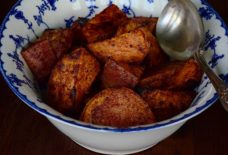Here it is: The Secret to Making Great Tasting Hummus
By: Cait O’Connor/ Arab America Contributing Writer
From black bean to caramelized onion to pumpkin spice, the flavors of hummus found on today’s grocery store shelves are seemingly endless. The humble paste of chickpeas and tahini has even been marketed in sweet “dessert” varieties.
But as marketers and food companies grow more creative, they deviate further and further from the delicious simplicity of the original dish, a rich, flavorful, wholesome blend of chickpeas, tahini, garlic, and a little lemon juice and salt.
Traditional hummus bi tahiniMany home cooks themselves struggle to replicate the silky smooth, a perfectly balanced flavor of traditional hummus. Too often, the results are grainy and bland, only reminiscent of that creamy dip served alongside crisp falafel and warm pita at restaurants and in homes across the Arab World.
While Western home cooks may never be able to replicate the original Egyptian and Levante techniques, chefs and food scientists alike have found ways to come close. The following are some tricks for a smoother, creamier, fresher, and more authentic creation.
THE INGREDIENTS
Fresh is always best! The beauty of hummus comes from the simplicity and delicacy of its very few ingredients. Take advantage of this fact by making yours with fresh, high-quality materials.
Chickpeas
This protein-packed legume is the star of the show, but the secret to ultimate creaminess comes from cooking the chickpeas until they are very soft. Super soft chickpeas are key for creamy hummus. Canned chickpeas are firmer than beans that are dried, soaked, and boiled at home. For best results, start from dry. If the chickpeas can be mashed with your thumb, they are soft enough to be used.
Many home cooks may be inclined to use canned chickpeas. While this is alright in a pinch, canned chickpeas are generally harder than desired. If using canned, boil the chickpeas for about 20 minutes before blending to soften and get rid of the “canned” flavor.
Tahini
Most American recipes skimp on this rich sesame seed puree, replacing it with olive oil or other unnecessary additives to achieve a greater dip-like consistency. For maximum nutty flavor and smooth texture, a ratio of 4 parts chickpeas to 3 parts tahini is recommended. (For every cup of chickpeas, use ¾ cup tahini).
For authentic results, save the olive oil (extra virgin preferably) for a garnish splashed over the top. Not only will the hummus itself retain its pure, authentic flavor and texture, but the complementary fruity flavor of the olive oil itself comes through more strongly as well.
Garlic
Aside from a plethora of health benefits, garlic gives hummus its signature powerful kick. To tone down this pungent flavor, try adding cooked garlic. Tossing the garlic cloves in with the chickpeas or roasting them lightly before blending will give the hummus a sweeter, more mellow garlic flavor. Try using 3-4 cloves of garlic per 1 cup of chickpeas.
To minimize the raw-garlic pungence without cooking, slice each clove in half before using and remove any green sprouts on the inside. These indicate age and increase the strong garlicky flavor.
Lemon
For best flavor and freshness, opt for fresh-squeezed lemon juice rather than bottled, which runs the risk of giving your hummus a rancid flavor, as does cheap or expired tahini. Try using 1/8-1/4 cup lemon juice per 1 cup of chickpeas.
Chickpea Skins
The lesser-known component of the popular legume is its thin, papery outer skin. These are unseen, yet critical for hummus production. When blended together with the other ingredients, these skins can make the texture grainy and chunky. Rubbing and rinsing can remove the skins from canned chickpeas, but this is a tedious and time-consuming process. An easier and more effective method follows…
THE PROCESS
Soaking/Boiling
The unsung hero of homemade hummus is…baking soda?! This unexpected kitchen staple is cited by many as the secret to smooth, idyllic hummus! Adding baking soda is a critical aspect of the cooking process, as it encourages the chickpeas to lose their shells, making them creamier and resulting in a smoother finished product. Soaking dried chickpeas in cold water and a teaspoon of baking soda will begin this process. After letting them soak overnight, boil the chickpeas in water and an additional teaspoon of baking soda. The baking soda raises the pH of the water, allowing the chickpeas to break down more completely, resulting in a smoother and creamier finished product.
The baking soda also chemically reacts with the skins, beginning to dissolve them during the cooking process. Placing the cooked chickpeas in an ice bath as soon as they are done boiling will allow the skins to rise to the surface of the water, where they can be easily skimmed off before blending.
Blending
A blender will suffice, but for maximum creaminess, a food processor works best in breaking down and blending all ingredients thoroughly.
Order of Ingredients
Start with the tahini, garlic, salt, and a little water. Whipping these ingredients first will add air to the final mixture, making it lighter and creamier. Add the chickpeas after these are combined, add the chickpeas gradually, using a little water with each addition to increasing the volume and fluffiness.
The Finishing Touches
These days, grocery store hummus can be found in seemingly infinite varieties, with many additives and accessories. For an authentic presentation and flavor, stick to the traditional garnishes:
- A sprinkling of paprika or za’atar
- A splash of olive oil
- Chopped parsley
- Whole chickpeas
Serving
Don’t wait! At this point, it should be hard to resist sampling your delicious concoction, but in any case the finished product is best served immediately, not chilled.
If you have to refrigerate it, let the hummus come back to room temperature before serving, readjusting seasonings and whipping slightly to restore the creaminess and texture.
For further inspiration, find the “The Greatist’s” hummus recipe here!



